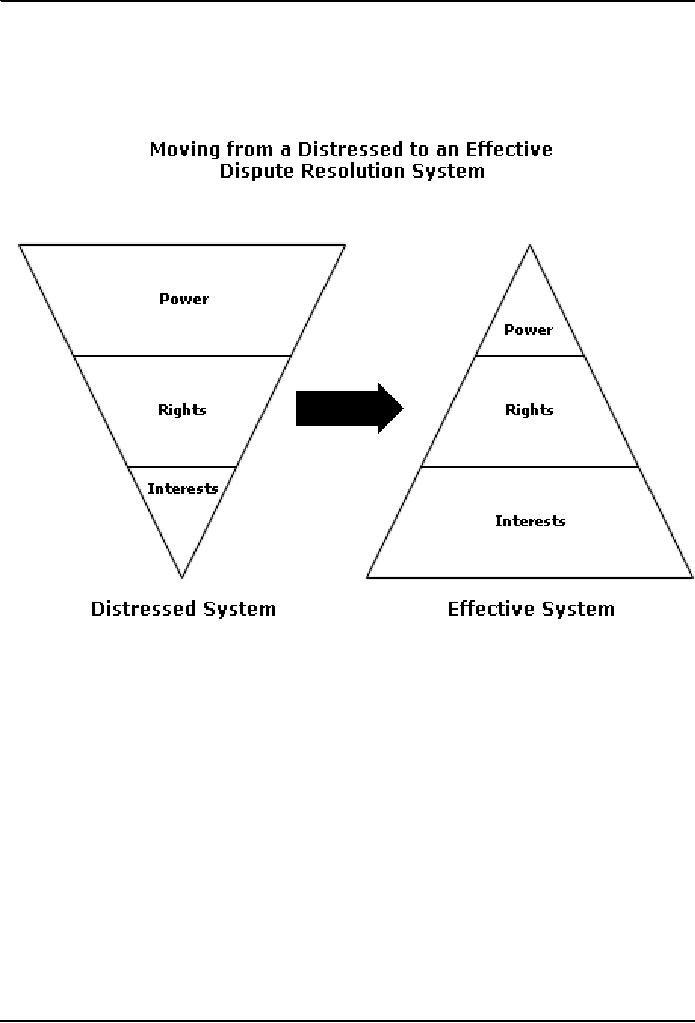 |

Conflict
Management HRM624
VU
Lesson
41
MIXED AND
MULTIMODAL DISPUTE
RESOLUTION
Designing
New Dispute Resolution
Systems
The
first heuristic involves the relationship
between three ways of resolving
disputes: by negotiating
interests,
by adjudicating rights, or by pursuing power options
(such as strikes or lockouts).
The
following diagram shows a
distressed conflict management
system, such as the one
found at Caney
Creek
before it was improved, and a healthy
dispute management system
that resolves most disputes
at the
interest
level, fewer at the rights level, and
fewest through power options.
This is healthy for
several
reasons.
Negotiating
interests is less expensive
than adjudicating rights or pursuing power
options.
Negotiating
interests results in mutually
satisfactory solutions, while the other
two approaches are
win-lose,
meaning
one side wins and the
other side loses. When
power-based approaches are
tried, the losing side
often
is angry, and may try to
"get back" at the other side
whenever they get the chance.
Interest-based
negotiation
is usually less time consuming
than the other
approaches.
Six
System Design Principles
1. Put
the focus on interests. This
means any dispute resolution
should start with a process
(either
direct
negotiation or mediation) where the
parties try to solve the
problem using
interest-based
bargaining. This is
the best way to find a
solution that satisfies
everyone. Only when this
doesn't
work,
you move on to rights-based processes
(such as arbitration) or power-based
processes (such
as
elections).
2. Provide
low-cost rights and power backups.
Arbitration, voting, and
protests are low-cost
alternatives
to rights and power contests. Although
they are higher in cost than
negotiation, they
are
less costly than adjudication or
violent force.
3. Build
in "loop-backs" to negotiation.
Rights-based and power-based
strategies for resolving
disputes
seldom need to be played out
to the end. Rather, as soon as it is
clear who is going to
"win,"
parties can return (the
authors call this "loop-back" to
negotiation to develop a solution
which
best meets their needs, as
well as their rights). A common
example of such a
"loop-back"
process
is when parties settle a lawsuit
out of court. As soon as it becomes
clear who is likely
to
win,
it is advantageous for both
sides to avoid the costs and
uncertainty of further litigation,
and
negotiate
a solution to their
dispute.
4. Build
in consultation before, feedback
after.
Increasing shared information is a
basic strategy in
ameliorating
all conflicts. Consultation and feedback
mechanisms between parties
provide a
consistent
and reliable method of sharing
information.
5. Arrange
procedures in a low-to-high-cost sequence.
Dispute-resolution
systems typically
have
a
series of steps. If one has
a grievance or a conflict with another
person or an organization, first
you
try to solve it on your own,
and then you seek the
help of a lawyer, etc. Ury,
Brett, and
Goldberg
advise that by arranging
dispute-resolution procedures in a low-to-high-cost
sequence
one
can reduce the probability of
rapid escalation. Minimizing this
tendency toward rapid
escalation
had
the added benefit of reducing enmity
and increasing faith in the
ability of the system to
resolve
basic
disputes.
6. Provide
the necessary motivation, skills, and
resources. An alternative
system can function
only
if people buy into it.
People are creatures of
habit, and this is the greatest
limit to broad-based
systemic
change. While there may be
active resistance from some
groups to new dispute-resolution
systems,
the greater problem is spreading the
skills, knowledge, and habits
that reinforce the new
138

Conflict
Management HRM624
VU
system.
It is incumbent on the elites in the conflict,
and third-party interveners, to
provide the
resources
and time necessary to generate
cooperation with the new
system.
Designing
New
Dispute
Resolution
Systems
While
every situation is unique, the typical steps
involved in dispute resolution
systems are the
following:
Dispute
Resolution System Design
1.
Establish a process for making
decisions about new or enhanced
dispute resolution
processes.
2.
Identify and diagnose the
causes of recurring ORG conflicts and
effectiveness of existing dispute
handling
procedures.
3. Examine the
range of options for
additional procedures or revisions of
existing procedures.
4.
Select or revise conflict
resolution procedures, considering the
corporate culture and the kinds of
disputes
that arise.
5.
Organize the selected procedures in a
comprehensive conflict management
system.
6.
Seek support from key
organizational constituencies and secure
approval for the proposed
new
system.
7.
Develop a plan for implementing the new
system and promoting its
use. Train personnel
to
administer
the system and to provide
specific services, such as
mediation.
8.
Create a process for quality
control, feedback and refinement of the
system.
Guiding
a Disputant
� Screening
clerk
Room
1
� Mediation
Room
2
� Arbitration
Room
3
139

Conflict
Management HRM624
VU
�
Face
finding
Room
4
�
Malpractice
screening panel
Room
5
�
Superior
court
Room
6
�
Ombudsman
Room
7
ADR
and the Internet
ADR of
cyber disputes: use of ADR
to resolve disputes occurring in the
online environment
Online
dispute resolution (ODR):
use of online platforms to
resolve conflicts of all origins
ODR
Varieties
Following
are some of the ODR
varieties.
1. ADR
by email
2. ADR
with web-based conferencing
3. ADR
using technologically sophisticated,
multimodal platforms
4.
Analytical tools added to
multimodal platforms
5.
Blind bidding sites
6.
Online summary jury
trial
Advantages
of ADR Conducted
Online
Following
are the advantages of the ADR
conducted online.
1.
Transcend geographic and
time-zone differences
2.
More immediate than letter
writing
3.
Time to diagnose conflict,
think, respond appropriately
4. Protect
intimidated disputants
5.
Separate enraged
disputants
6.
Handle disabilities that prevent
attending sessions
7.
Technologies allow better conflict
diagnosis
Disadvantages
of ADR Conducted
Online
Here
are some of the disadvantages of the
ADR conducted online.
1. Disempowers
computer-illiterate; people who write
poorly
2. Disempowers
people with impaired access to
Internet
3. Lack
of body language, technology problems
may produce
meta-disputes
4. ADR
neutrals lose non-verbal
information
5. Disputants
may abandon process
Dispute
Resolution System Design
Dispute
Resolution System Design is
1. Performed by
consultants
2. Used
by large organizations
3. Tailor
dispute resolution processes
and procedures to fit entity
or enterprise
Legal
Issues in ODR
There
are some issues which
are involved in ODR
e.g.
1. Where
did the dispute arise?
(cyberspace dispute choice of
law problem)
2. Where
is ADR taking place? (ADR
choice of law
problem)
3. How
can settlements be
enforced?
140

Conflict
Management HRM624
VU
Extensions
of Dispute Systems Design
Several
authors advocate refinements to
make dispute systems design
more effective. For example,
Rowe
suggests
that an effective dispute-resolution system should
incorporate:
1.
Commitment to the
values of fairness and freedom
from reprisal;
2.
Interest-
and rights-based
options;
3.
Multiple
access points;
4.
An organizational
ombudsperson;
5.
Wide
scope; and
6.
Continuous
improvement via an oversight
committee.
Lynch
argues that
an effective system should incorporate:
1. Responding
to stakeholder interest;
2. Reflecting
important values;
3. Promoting
the mission of the new
agency;
4. Providing
visible support by the organization's
leadership;
5. Loop-backs
forward and back between
interest- and rights-based
options;
6. A
system that is fair,
flexible, friendly, and
fast;
7. The
goal of resolution at a low level;
and
8. Mechanisms
by which the organization can shift
from conflict resolution to
management.
Extensions
of Dispute Systems Design
Slaikeu
and Hasson outline four
principles for an effective
system:
1. It should
acknowledge four means of
resolution (essentially, power, rights,
interest, and
avoidance);
2. It should include
prevention and early-intervention
options;
3. It should
seek to build collaborative strength
through seven
checkpoints;
4. It should
utilize the mediation model in order to
build consensus among those
involved.
Summary
Dispute
resolution systems are
necessary for resolving ongoing
disputes around us, in our
personal and
work
lives. ODR (online dispute
resolution) systems are also
becoming need of the time. People
are finding
solutions
through online
systems.
141
Table of Contents:
- INTRODUCTION TO CONFLICT:Dispute, Legal Dispute, Call the police
- DISPUTE RESOLUTION 1:Positive affect in Negotiation, Alternative Dispute Resolution
- DISPUTE RESOLUTION II:Adjudication, Litigation, Mediation-Arbitration
- PRECONCEPTIONS ABOUT CONFLICT I:Pedagogical development, Pressures against Innovation
- PRECONCEPTIONS ABOUT CONFLICT II:Cultural beliefs about interpersonal conflict, Why strategies of change fail
- CONFLICT DIAGNOSIS:Who Needs to Know About Conflict Diagnosis?, Steps in Conflict Diagnosis
- RECURRENT THEMES IN CONFLICT DIAGNOSIS I:The Seven Steps of Social Behavior, Seven steps to diagnose conflict
- RECURRENT THEMES IN CONFLICT DIAGNOSIS II:Themes of Conflict Diagnosis
- DESCRIBING THE CONFLICT I:Description of Conflict, Identifying Interpersonal Conflict
- DESCRIBING THE CONFLICT II:Step 1 for Conflict Diagnosis, interpersonal or intrapersonal
- SOURCES AND CAUSES OF CONFLICT I:Main Sources of Conflict, Discussing major sources of conflict
- SOURCES AND CAUSES OF CONFLICT II
- INTEREST ANALYSIS I:Analyzing your interests, Analyzing the other disputant’s interests
- INTEREST ANALYSIS II:What are interests?, Tips for Interest Trees
- INTEREST ANALYSIS II:Principles and values, Basic Human Needs
- ASSESSING THE CHARACTER OF THE CONFLICT I, Premises of Deutsch’s Theory
- ASSESSING THE CHARACTER OF THE CONFLICT II:Techniques to transform competitive conflict into cooperative
- TRUST AND ITS SIGNIFICANCE I:What is Mistrust,Trust and business,Three levels of trust
- TRUST AND ITS SIGNIFICANCE II:Advantages of high trust level, Building of trust
- ASSESSING IMPEDIMENTS TO RESOLVE THE CONFLICT I:Motivation to seek vengeance, Mistrust
- ASSESSING THE IMPEDIMENTS TO RESOLVING THE CONFLICT II:Disempowered Disputant, Unpleasant Disputant
- ASSESSING THE NEGOTIATING STYLE I:Dual Concern Model, Dominating or competition style
- ASSESSING THE NEGOTIATING STYLE:Dual Concern Model, Tactics Used In Integrating
- ASSESSING POWER AMONG DISPUTANTS:Conflict and Power, Kinds of power in the Relationship Domain
- ASSESSING POWER AMONG DISPUTANTS II:Sources of Relationship Power, Context and Power
- POWER, CONFLICT, AND BATNA III:Role of Third Party in BATNA, Dealing with Power Imbalance
- STEREOTYPES, DIVERSITY, AND CONFLICT I:Stereotyping, Stereotyping in Interpersonal Conflict
- STEREOTYPES, DIVERSITY, AND CONFLICT:Categories of Diversity Issues, Seven Mental Processes to Prove Stereotypes
- STEREOTYPES, DIVERSITY AND CONFLICT III:Individual Difference and Social Category, Cultural differences in values
- MEDIATION I:When is mediation required, Processes Related to Mediation, Product of Mediation
- MEDIATION II:Important distinguishing factors, More Advantages and Disadvantages of Pure Mediation
- ADVANTAGES AND DISADVANTAGES OF MEDIATION I:Efficiency Consideration, Conflict Management and Prevention
- ADVANTAGES AND DISADVANTAGES OF MEDIATION II:Quality of Consent, Effects on the parties to mediation
- PROCESS OF MEDIATION:Stages of Mediation, Facilitative tactics in mediation
- LAW AND ETHICS OF MEDIATION I:Characteristics of mediation, Confidentiality
- LAW AND ETHICS OF MEDIATION II:Role of ethics in mediation, 8 Dimensions of Ethics in Mediation
- ARBITRATION I:Ways to Resolve Conflict, Advantages of Arbitration, Disadvantages of Arbitration
- ARBITRATION II:Varieties of Arbitration, Process of Arbitration, Contents of Arbitration Act
- NON BINDING EVALUATION:Disadvantage, Varieties of Non-binding Evaluation
- NON BINDING EVALUATION II:Varieties of Non-binding Evaluation, Advantages and disadvantages of Non-binding Evaluation
- MIXED AND MULTIMODAL DISPUTE RESOLUTION:Six System Design Principles, Extensions of Dispute Systems Design
- POWER TOOLS AND MAGIC KEYS I:Introduction, Necessity of conflict diagnosis, Using conflict diagnosis
- POWER TOOLS AND MAGIC KEYS II:Proposed Contents of a Clients’ Interview, Impediments to use facilitative mediation
- PANCHAYAT, LOCAL GOVERNMENT SYSTEM, AND ADR, Definitions of Panchayat, Definition of Jirga
- SUMMARY AND MESSAGE OF THE COURSE:Definitions of conflict, Negotiation, Meditation, Adjudication